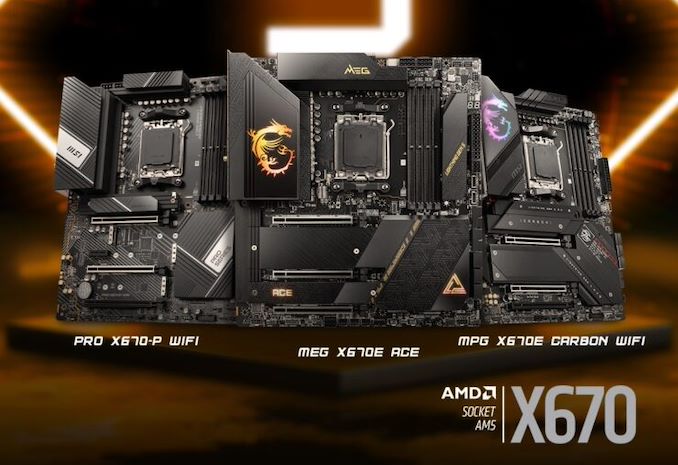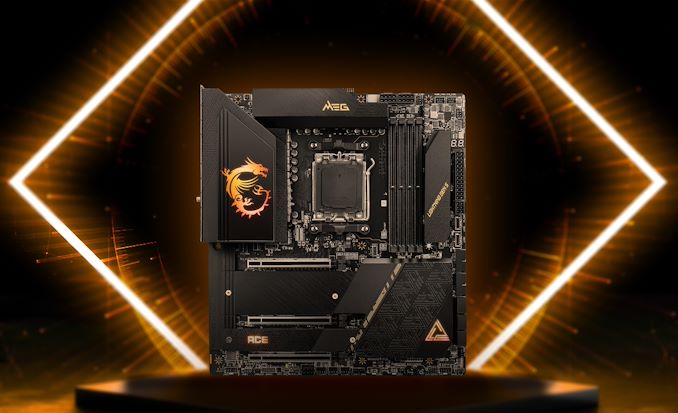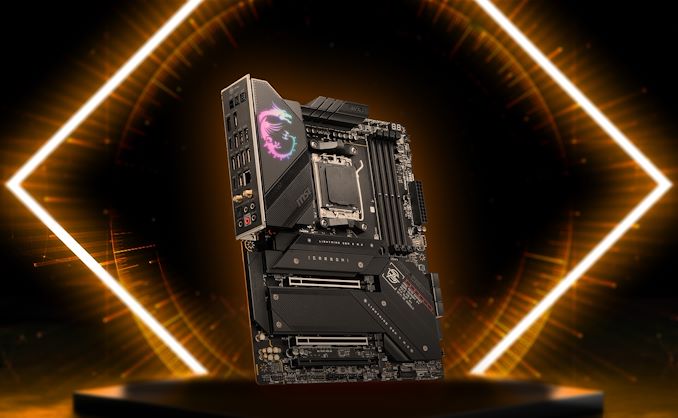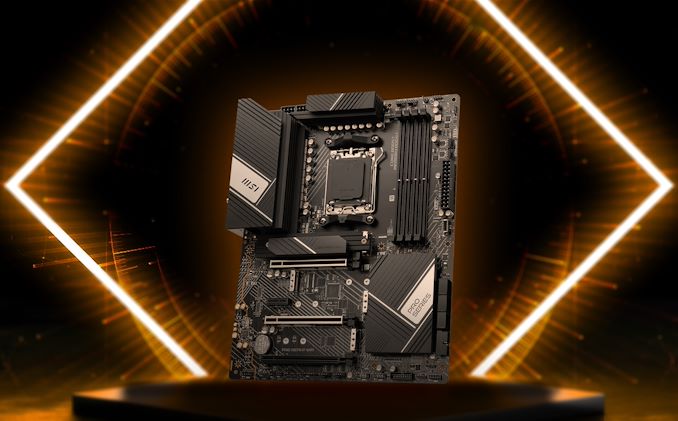Computex 2022: MSI Announces Three AM5 Motherboards For Ryzen 7000 Processors
by Gavin Bonshor on May 24, 2022 12:00 PM EST- Posted in
- Motherboards
- AMD
- MSI
- Trade Shows
- Zen 4
- AM5
- LGA1718
- Ryzen 7000
- Computex 2022
- X670E
- X670

During Computex 2022 in Taipei, Taiwan, MSI unveiled four AM5 motherboards designed for AMD's Ryzen 7000 processors, which will be landing later this year. Currently announced are the premium MEG X670E Ace, the mid-ranged MPG X670E Carbon WIFI, and the more business-focused Pro X670-P WIFI motherboards.
Hot on the heels of AMD's announcement that its highly anticipated Ryzen 7000 processors for desktops will be dropping sometime in the fall, motherboard vendors have been slowly unveiling what boards we can expect to see at launch. MSI has dropped some limited information on four new AM5 boards, including two from its flagship MEG series, one from its gaming-focused MPG family, and one from its more affordable Pro series.
Here is what we know so far:
Although MSI has announced there will be an X670E Godlike, we currently don't have any images for this model. As we know from previous motherboard launches, the MSI X670E Godlike will be the company's flagship AM5 board for Ryzen 7000 processors, with a large E-ATX sized PCB and a wave of high-end enthusiast-level features. One interesting feature of the MEG series boards is a front panel USB 3.2 G2x2 Type-C header with support for 60 W power delivery.
MSI hasn't specified much or distinguished much of its announced features between either model. Still, MSI does say the MEG series for AM5 includes a monstrous 26-phase power delivery (24+2) with 105 A smart power stages and a stacked fin array heatsink to help cool it. MSI also states that the MEG series will include a large metal backplate with up to four M.2 slots onboard and an M.2 Xpander-Z Gen5 dual add-on card supporting two PCIe 5.0 M.2 SSDs. Whether these features are specific to the entire MEG series for AM5 remains to be seen.
The MSI MPG X670E Carbon WIFI uses a carbon black finish across the board, with two full-length PCIe 5.0 slots. MSI states the X670E Carbon WIFI will include four PCIe 5.0 M.2 slots and that the board will be powered by a 20-phase (18+2) power delivery with 90 A power stages.
MSI's fourth and final model is the Pro X670-P WIFI motherboard, which is primarily aimed at SMEs and users looking to build a more professional type system. MSI says the X670-P WIFI will include a 16-phase (14+2) power delivery, with a single PCIe 5.0 M.2 slot and 2.5 GbE/Wi-Fi 6E networking.
At the time of writing, MSI hasn't provided any information regarding controller sets at this time, or how much each of the four models might cost. MSI will likely give more details closer to the launch of the AMD Ryzen 7000 CPUs, which are expected to hit retail shelves in Q4 2022.
Source: MSI



















12 Comments
View All Comments
Marlin1975 - Tuesday, May 24, 2022 - link
I am more curios to what the price differance will be between the boards using the 3 chipsets.Also any infomation on where the chipsets are made and what node?
CrystalCowboy - Tuesday, May 24, 2022 - link
The chipsets are TSMC N6. I don't know about the price difference.CrystalCowboy - Tuesday, May 24, 2022 - link
I could be wrong about that, I might be thinking of the I/O chiplet in the 7000 processors. Am currently hunting for a source.CrystalCowboy - Tuesday, May 24, 2022 - link
Promontory 21 chiplet from ASMedia. Possible involvement by MediaTek at a later date. 7 watts per chiplet. The X670 and X670E will have two of these chiplets, the B650 will have one. No mention of fab.https://www.tomshardware.com/news/amds-multi-chipl...
https://www.angstronomics.com/p/site-launch-exclus...
CrystalCowboy - Wednesday, May 25, 2022 - link
It says here the chipset is TSMC 6 nm, so I might be accidentally right.https://www.tomshardware.com/news/msi-showcases-am...
"As expected, ASMedia designed the X670 chipset, a product of TSMC's 6nm manufacturing process. It's a nice upgrade since X570 was on GlobalFoundries' 14nm process node."
andychow - Wednesday, June 1, 2022 - link
Huge upgrade. Won't need an active cooler for the chipset.CrystalCowboy - Tuesday, May 24, 2022 - link
Slot drought - Once upon a time, PC motherboards supported up to 7 expansion slots. Each of the 3 boards pictured above has 3 x16(physical) slots, and the one on the left also appears to have a single x1 slot. I can come up with a number of possible reasons for this. Motherboards come with more included these days. USB is much more capable than in the old days. Big graphics cards hog 2 or 3 slots of physical space. And any extra PCIe lanes are likely to be used for extra M.2 slots, which are very popular.ballsystemlord - Tuesday, May 24, 2022 - link
In spite of the excuses, the lack of slots is still a problem for anyone who wants to expand on their PCs capabilities.CrystalCowboy - Tuesday, May 24, 2022 - link
Agreed. I recently had to physically cut down a network card to fit an x1 slot to get the number of ports I required.ballsystemlord - Tuesday, May 24, 2022 - link
Aside from liquid nitrogen cooling, can anyone think of a reason why a CPU would need a 20 or 26 phase VRM?Normally, anything beyond 12 (decent phases) is way over built for -- at least if you talk to Buildzoid. I mean for powerdraws through 400w.